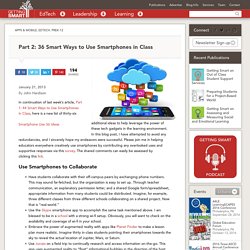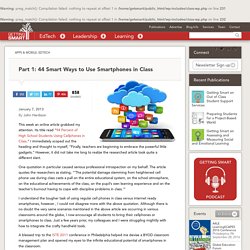

Do BYOD Programs Encourage Bullying? In theory, Bring Your Own Device (BYOD) programs in schools are a great idea; students can use their own tablets, laptops and smartphones in the classroom, and can take advantage of a wider range of apps and programs than they might be able to normally access in school.

There is a case to be made that doing so can make schools more cutting edge and capable of engaging students through methods that they're comfortable with. However, there's also a risk that BYOD could lead to bullying and inequality within schools. How, then, can BYOD be successful without causing these kinds of problems? The growing popularity of BYOD is a trend that has appeared in the workplace and schools over the past few years; partly, this has been in response to gaps between the technology found at work and school, and what people are using in their spare time. For schools, particularly those whose budgets are struggling to keep up with the pace of technology, BYOD offers cost savings. Transforming schools and classrooms into learning communities with personalized technology tools.
Edn Impact and Padagogy Change. Case Studies. Planning for Implementation. Everything BYOD! 20 BYOD Resources For The 21st Century Schools. By Hope Mulholland, TeachThought Intern BYOD policies–Bring Your Own Device–allow schools to bring technology into the classroom with a “bottom-up” approach.

Such an approach can save money, allow students to use their own devices, and encourage a student-centered approach to learning. Recently we explained that “digital natives or not, technology dropped into the laps of students in schools isn’t always as accessible as it might be. Part 2: 36 Smart Ways to Use Smartphones in Class - Getting Smart by @JohnHardison1 - In continuation of last week’s article, Part 1: 44 Smart Ways to Use Smartphones in Class, here is a new list of thirty-six additional ideas to help leverage the power of these tech gadgets in the learning environment.

In this blog post, I have attempted to avoid any redundancies, and I sincerely hope my endeavors were successful. Please join me in helping educators everywhere creatively use smartphones by contributing any overlooked uses and supportive responses via this survey. The shared comments can easily be assessed by clicking this link. 44 Smart Ways to Use Smartphones in Class (Part 1) - Getting Smart by @JohnHardison1 - This week an online article grabbed my attention.

Its title read “94 Percent of High School Students Using Cellphones in Class.” I immediately scoped out the heading and thought to myself, “Finally, teachers are beginning to embrace the powerful little gadgets.” However, it did not take me long to realize the researched article took quite a different slant. One quotation in particular caused serious professional introspection on my behalf. The article quotes the researchers as stating, “‘The potential damage stemming from heightened cell phone use during class casts a pall on the entire educational system, on the school atmosphere, on the educational achievements of the class, on the pupil’s own learning experience and on the teacher’s burnout having to cope with discipline problems in class.’” I understand the tougher task of using regular cell phones in class versus internet ready smartphones, however , I could not disagree more with the above quotation. An international forum for all schools seeking to make the best use of BYOT.
Are Schools Prepared to Let Students BYOD? - Finding Common Ground. "Districts wading into the "bring-your-own-technology," or BYOT, waters are wrangling with which issues should be tackled through districtwide policy, and which should fall under school-level procedural codes.

In the process, they're trying to leave room to solve unanswered legal questions about Internet security and privacy. " Quillen (Education Week) As our students get older, they become more responsible...we hope. A laptop or tablet has replaced the notebook and pen over the past few years since our present technological explosion. Why Mobile Learning Is Inevitable. This may sound like a lofty title, but it’s not wrong. There’s an impressive presentation making the rounds dubbed “Mobile is eating the World” by Benedict Evans. In the presentation, Evans shows some staggering charts, interesting factoids, and all the other statistics you’d expect with a title so grand. It makes me think about mobile learning, mobile browsing, and mobile everything.
But the real story here is about education. Why BYOD Is A Disaster Waiting To Happen For Schools. BYOD in K-12 schools presents massive challenges to IT staff, administrators, and teachers Apple firmly positioned the iPad as an education solution during its education even in New York five months ago.

Even before that, many schools and districts had begun pilot programs of full on iPad deployments. The iPad provides many opportunities in education as well as some challenges. One of those challenges is cost. That’s not a surprise, considering the number of iPads required in order to give one to each student in a district. Given the cost of such deployments and the attention that BYOD programs have gotten in both the tech and mainstream media over the past year or so, it was only a matter of time before someone in the education technology sector began to talk up the idea of BYOD in education as a way to cut the costs associated with such deployments. Generally, I’m a cautious fan of BYOD. BYOD will almost certainly create a very uneven education playing field for students.